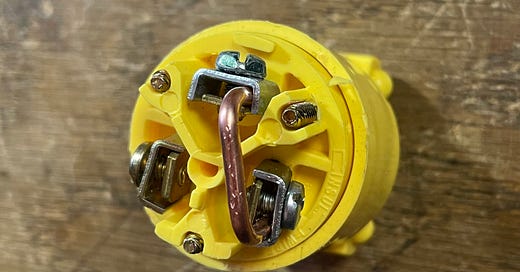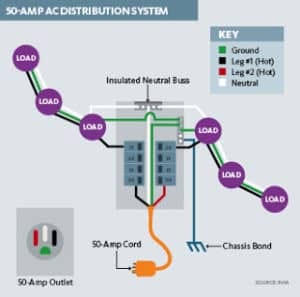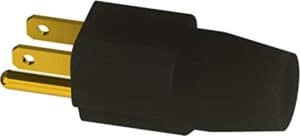Dear Readers,
In response to several inquiries about how to make your own neutral/ground generator bonding plug, here’s the full DIY generator bonding plug article I wrote over 10 years ago.
When a portable generator won’t power your RV
I received this email from a reader who wants to power his RV from a Honda portable generator.
I have a 2011 Fleetwood 40-footer. I’m trying to get my Honda EU3000 generator to power up the motorhome for a few items. My display after plugging in will show NO LOAD. This generator will power anything else I try such as a 30-foot trailer with one air conditioner, compressor, etc. I also have a Coleman 5000 and that will power up the motorhome.
I have an adapter cord 50-amp female going to 30-amp (3 prong) male. The Honda worked with my 2002 Monaco hooking the same way. The reason I like to use the Honda is when I am at the track this time of year, there is no need to run the motorhome generator since there is no need for air conditioning. I have called Honda and they were no help. —John Z., Purcellville, VA
Basic Ground-Neutral bonding theory
John, all RV electrical systems are wired with their Ground and Neutral buses floated (unbonded from each other). There are lots of good reasons for this, most specifically that it’s an NEC and RVIA code requirement that the safety ground wire never carries any load current. Also, there can be only one Ground-to-Neutral bonding point in any distributed electrical system in the USA.
Now, when you’re plugging your RV into power from a building (your garage outlet) or campground (pedestal outlet), your RV has its Ground and Neutral buses “bonded” (connected) together externally as part of the service panel’s earthed safety ground system. Again, lots of reasons for this, but the fact is you can only have a single G-N bonding point according to the National Electrical Code and RVIA building codes.
When a floating neutral generator won’t work…
See my video on testing for a floating neutral HERE.
So when your RV is powered by its on-board generator, this G-N bond connection is created by the transfer switch set to generator mode. But when the transfer switch is set to receive shore power, your RV expects the external power source to bond its Ground and Neutral wires together.
Now, if you have an inline voltage monitor system from a manufacturer such as Surge Guard or Progressive Industries, your voltage monitor is checking for the Neutral and Ground voltages to be very close to each other, probably within 3 volts or so.
This works well if you’re plugged into shore power that’s properly grounded and bonded, but this voltage protector can be tripped off by plugging your RV shore power plug into a portable generator without an internal Neutral-Ground bond. If you don’t have a voltage protection device on your RV, then you may never know that your generator has a floated neutral (unbonded G-N bus).
Generator types
Contractor-type generators such as your Coleman 5000 are generally N-G bonded internally, which is why it runs your RV just fine. However, many portable inverter generators from companies such as Yamaha and Honda (your EU3000, specifically) have floated Neutrals (no internal Neutral-Ground bond) since they expect an external N-G bond to happen somewhere else. And while RV-approved generators may have an internal N-G bond, it seems that many of the most popular portable inverter generators from Honda and Yamaha have floating neutrals.
Honda help desk couldn’t help
I discussed this very point with Honda engineering, and they confirmed that their inverter generators have floated Neutrals and they simply say that you should follow all local electrical codes for bonding-grounding. So your EU3000 isn’t providing the Ground-Neutral bond that your RV requires to think it’s getting properly grounded power, while your Coleman 5000 has a Neutral-Ground bond already so it operates your RV properly. Seems crazy, but that appears to be the scenario.
DIY your own…
It’s pretty simple to wire a special “Neutral-Ground bond” jumper plug for your Honda or Yamaha generator which will allow you to power your RV through its voltage protection device. You can obtain or make a dummy 15-amp “Edison” plug with the Neutral (white) and Ground (green) screws jumped together with a piece of 12- or 14-gauge wire (see photo below).
This G-N jumper plug can be plugged into one of the generator’s unused 15- or 20-amp outlets, and the entire generator’s electrical system will be N-G bonded. You can then use the other 20-amp Edison outlet or the 30-amp outlet to power the RV.
Just be sure to mark this plug specifically for its intended purpose. It won’t really hurt anything if it’s plugged into a correctly wired home outlet. But it will create a secondary G-N bonding point that could induce ground loop currents and create hum or buzz in a sound system. That doing that will also guarantee any GFCI outlet in the branch circuit to trip with even a few mA of load current.
Buy one that’s factory made
If you’re not 100% comfortable wiring your own N-G bonding plug, then you can buy one from Southwire on Amazon for less than $17 delivered. I keep one in my gig-bag for when I have to power sound systems from a Honda generator, and it works great for that application as well. But if you don’t have any sort of EMS/Advanced surge protector, or you’re not powering sensitive electronics, you probably don’t need an N-G bonding plug at all. But when you need it, you’ll really need it. Buy one from Amazon HERE.
Note that this is a Generator-Only G-N bonding plug which should be only plugged into a portable generator while powering your RV. It should never be used to create a bootleg ground in a residential or RV outlet that was not properly wired with a ground conductor.
Let’s play safe out there…. Mike












I wanted to ask, I have a shed running on a portable solar generator. I want to earth ground it for safety and the EcoFlow does not have a ground bolt. I was wondering, could I create a N-G bond plug that has the N-G bond connected to a third grounding cable that is attached to a ground post outside? I appreciate your insight